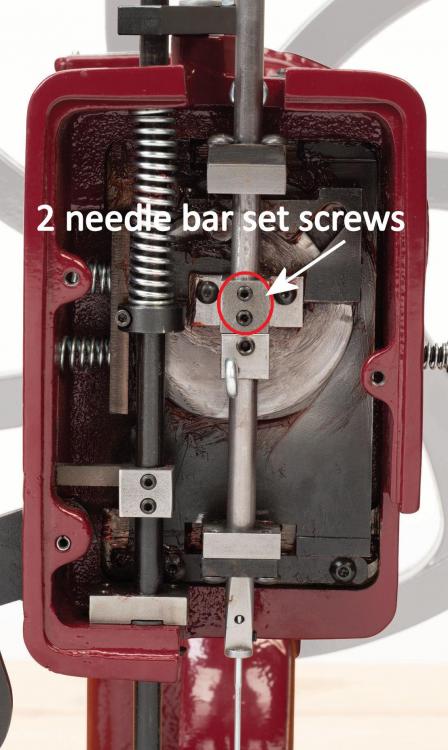-
Posts
5,754 -
Joined
-
Last visited
Content Type
Profiles
Forums
Events
Blogs
Gallery
Everything posted by Constabulary
-
@DavidJohn Quite and old post you reply to but anyway. "Powerful machine" is a point of view and depends on what you want to sew. The power is not inside the machine the power comes from the motor that drives the machine. So question rather is: Right machine + motor for the job - or not. I would generally agree that a German made sewing machine from the 1950s / 1960´s will last longer than a modern Chinese made machine BUT the machines have to come from the same class otherwise it is like comparing apples and eggs. So a general statement that "a" Chinese made machine will not last longer that the Pfaff 230 is not the "full truth". There comes crap from China but also very well built machines. The 230 is not an industrial machine, it is well built but it still it is a domestic machine that has it´s limitations. If I had to choose lets say between a Pfaff 230 and a Chinese build Singer 20U clone I would go with the 20U clone (and I´m by far not a big fan of Chinese made machines). But thats still comparing apples and eggs. As I said before the work you want to do decides which type of machine you will need. @chrisash I recently bought some presser feet from a Chinese Ebay seller and they were so dirt cheap I did not expect very good feet at all (wanted to modify them anyway). But what I received was far above my expectations. Totally smooth bottom side and very well finished. So yeah - you can buy cheap and receive crap but you can also buy cheap and receive excellent quality. Thing is you never really know what you will get when you buy from "these sellers" that sell all kind of odds and ends and are not focused on a certain branch. I guess a lot of the "odds & Ends" seller just sell overstock / surplus parts they buy in bulks or so. To be honest the percentage of crap items I received from China is fairly low. The majority of parts I have received (yet) where good to very good.
-
I once got a bunch of "strap folder" for double needle machines from a closed leather business. Most are gone (sold too cheap) and I only have 2 left. Never used them but you never know. They are single folds so I do not know what kind of strap they used it for. I´m sure there are other strap folders out there that produce clean edges (triple fold?). Maybe clean edge binder attachment can do the work but of course depends on the leather you want to use.
-

seiko Any SEIKO LSC-8B-2 specialists here?
Constabulary replied to RodS's topic in Leather Sewing Machines
I meant the suspending edge guides here - sorry.- 6 replies
-
- cylinder arm
- compound feed
-
(and 2 more)
Tagged with:
-

seiko Any SEIKO LSC-8B-2 specialists here?
Constabulary replied to RodS's topic in Leather Sewing Machines
Lots of questions. I can speak for the Adler 69 which technically is a very similar machine. The basic machine is the same - the difference between the two is the arm cover plate, feed dog, presser foot set and throat plate which are interchangeable. Basically you can turn the "regular" model into a binder machine and vice versa. If you have a binder machine and want to do regular sewing you can remove the binder attachment and you are done BUT the binder bracket is moving back and forth and you still have the 2 screw post that hold the binder bracket - so that's the cheapest solution. The better and cleaner more professional solution is replacing the throat plate, feed dog, presser foot set and the binder bracket (this will be replaced by an arm cover plate). A swing away binder is usually used on a standard machine / a machine w/o synchronized binder only. I have not seen a SAW Binder on a synchronized binder machine yet. You can DIY flat bed attachments if you are DIY guy or gal or maybe a Pfaff 335 oder Adler 69 attachment could work too Forum search: https://www.google.com/search?client=firefox-b-d&q=flatbed+attachment+site%3Aleatherworker.net%2Fforum%2F You can buy swing away binders on ebay for bargain prices you just need a adapter bracket for your machine - can be DIY too or you look up a machine specific adapter bracket.- 6 replies
-
- cylinder arm
- compound feed
-
(and 2 more)
Tagged with:
-
Very nice! May I ask where do you buy the binding tape in OD and Koyote?
-

Help identifying a Consew machine
Constabulary replied to WeiFeng's topic in Leather Sewing Machines
and something that might e useful too (came from Keystone Sewing Machines in PA): Singer 111W Consew 225 REPAIR_compressed.pdf -

Help identifying a Consew machine
Constabulary replied to WeiFeng's topic in Leather Sewing Machines
Here is one 225.pdf -
The long arm 29 / 29Ks have a wider base so the short arm 29 / 29K fit on the long arm treadles but IIRC not the other way around - except you "cobble" an extension.
-

Weaver Cub trouble shooting
Constabulary replied to Faithfulcowgirl's topic in Leather Sewing Machines
The hook is shredding the thread just occasionally so IMO the needle bar is too high. That usually is a very small problem and easy to fix when you have the timing values. As a workaround w/o knowing the timing values and if it was my machine I would loosen the 2 screws that hold the needle bar in place and just lower the NB a tiny bit (maybe 0.5mm - 1mm) and check again. Again - this is what I would do or try w/o knowing this particular machine. But the NB/ Hook timing is very similar on this type of sewing machines. -

Weaver Cub trouble shooting
Constabulary replied to Faithfulcowgirl's topic in Leather Sewing Machines
to me it looks like the hook tip is shredding the top thread. I would try to lower the needle bar a little bit. What does the manual say regarding needle / hook timing? EDIT: I don´t know the Weaver machine in particular but usually on large barrel hook machines you bring the NB to bottom dead center and raise it 4mm - 5.5mm (depends on machine) and at this point the the hook tip should meet needle in the center of the needle scarf or 2.5mm above the needle eye to ensure the hook tip is gripping the thread loop properly. EDIT II: I just checked the manual it says you should call Weaver if you have a timing issue If you call them maybe you can share the needle / hook timing values -
Susan, the the post you reply to is 9 yrs old
-

Suggestions for mitigating eccentric needle bar hole
Constabulary replied to rlevine's topic in Leather Sewing Machines
IMO Singer 111w or 107w needle bars should work. -
Definitions may differ in different countries but a term you often read in terms of small business made items in MANUFATUR. I know the translations may throw out different meaning. A MANUFAKTUR may differ in sizes (number of employees and so forth) depending on the branch but usually - nowadays - when you read MANUFAKTUR over here (like leather MANUFAKTUR, Glass MANUFAKTUR....) is most of the time is associated with a small business producing high quality goods in a rather small volume (again - depends on the definition) with a high amount of hand and / or art work. Not sure if MANUFAKTUR has the same meaning worldwide and history for has changed the meaning but that pretty much the definition in the "old world" nowadays: https://de.wikipedia.org/wiki/Manufaktur#Der_moderne_Begriff (use googel translate) We don´t have to look far - same with sewing machine like ARTISAN or COWBOY or THOR. No one in Europe (I guess) would call his sewing Machine Co. COWBOY - of course it´s a different story in the US. It gives you a certain association with something most folks (in the US) are familiar with - the original Co. name is HIGHTEX IIRC - so calling it COWBOY is a marketing name tailored to the US market. THOR and ARTISAN of course gives certain associations with something else. Thats marketing! Not meant as an offense to the brand names!
-

Singer 45K89 Jump Foot + Reverse on Ebay UK
Constabulary replied to Constabulary's topic in Leather Sewing Machines
I have not received a PM from you recently. Anyway the 45K is on the wrong side of the pond for me. -
https://www.ebay.co.uk/itm/133783169564 Again - wrong side of the pond for me Hope it will find a good new home. EDIT: and a Class 17 too: https://www.ebay.co.uk/itm/133783286307 EDIT II: Frobana Outsole Stitcher + Singer 29K58 from another seller: https://www.ebay.co.uk/sch/johmarshal-43/m.html?_nkw=&_armrs=1&_ipg=&_from=
-
https://www.ebay.co.uk/itm/284317686311 what a cool old machine. I hope a member from the UK can rescue this beauty and restore it. I would love to but I´m on the wrong side of the channel.
-

Specialty equipment: leather buttonhole machines
Constabulary replied to regius's topic in Leather Sewing Machines
201 is a Singer domestic sewing machine -

Specialty equipment: leather buttonhole machines
Constabulary replied to regius's topic in Leather Sewing Machines
with a button hole attachment like YS Star 4455 or FAMOUS or Singer 121795 and the like. I just bought one myself the other day (not received yet). -
Check the feet I have linked above - they have a 12mm wide slit. But I received them in chrome instead of black but I really like the quality. Crazy cheap price! I also have a Singer 307G2 - extremely smooth running machine. And it can use the needle plates and feed dogs of the above mentioned Singer models too - it has 2 sets of screw holes for needle plate - don´t ask me why its not mentioned in the manual. I like a lot better that the 138 (had one many years ago). I never have used a Singer 457 and my 143w just set up for 8mm ZZ but I still have to play with the ZZ timing a bit. The 307G2 also has the same hook as my107w and 143w. While looking for wide ZZ plates for my 143 I came across this set - it pretty much looks as if it could fit the 138 or your 114 - or not? Maybe worth trying. https://www.ebay.com/itm/144017485507
-
Foot bar diameter is 8.7mm. Distance between foot bar and needle bar is 14.8mm. Hope this helps.
-
Yes, the Dürkopp 252 is using the typical Singer industrial feet. I will check the diameter and foot bar - needle bar distance on my 107w / 143w later so you can compare if it is the same on the 114. If so a Singer 111w foot bar should work. If it was a Singer based machine you could even use 20U, 107w, 143w and 457 needle plate, feed dogs and all the feet. But Pfaff always was / is a bit special and therefore often the part prices are sky high. The Pfaffs are more comfortable but the availability off accessories makes Singer my favorite brand. Just recently I bought 2 19mm wide feet for a bargain (made in China bu excellent quality). I want to customize them for sewing ZZ tacks. https://www.ebay.de/itm/402635855188 But let me guess - Pfaff 138 feed dogs and needle plate could work for your machine. And without knowing I think the 138 feet could fit as well.
-
Not really - you find them sometimes but they are not wide spread. Another very equivalent is the Durkopp 252. I have a German langue 252 manual if that helps (not much I guess).
-
Do you have a link to that video? Screw in type needle holder is the most common nowadays. Well I do not know your needle bar. Is the needle holder replaceable - probably? If yes maybe you can just replace the needle holder and you are done. But I don´t know your machine... If not then the NB diameter also matters. The timing marks do not work when you install the NB in a foreign machine but that does not really matter. Well, a double needle machine is a different story. I have single needle machine and used a needle bar from a Dürkopp machine which I had in my spare parts box and because it was shorter than the OEM NB I had to install a longer NB Guide. I´m not sure if you want to go that way. It may require drilling out the casting if you cannot find a NB guide with the correct length and diameter. If I was in your position and cannot replace the needle holder then I would look for a Singer 212 needle bar. I´m not sure maybe there is a double needle bar which is longer but I don´t know so my choice would be a Singer 212 NB. Then you need a needle holder with the correct needle distance that matches your needle plate. Needle bar: https://www.ebay.com/itm/153445408972 For the needle holder you most likely have to buy a whole 212 gauge get with correct needle distance - not sure what your needle distance is https://www.ebay.com/itm/142635430976
-
What model re you talking about? Buying a from a dealer with good reputation can be the key. Is the used one from a private seller? Even new machines from a dealer can cause issues - you never know until things go wrong. It depends on how well the machine is serviced and / or set up to your requirements. I have zero new machines all my machines are vintage and refurbished (more or less). My oldest is from the 1920´s - 1930´s - no problems.
-
That's why I upgraded my 51w with a new needle bar so it can use 135x17 needles or generally common needles with a 2mm shaft. Almost all of my machines I have set up to 135x17 / 135x16 needles so I don´t have to stock different needle of all kind and sizes. Makes sewing life a bit easier



